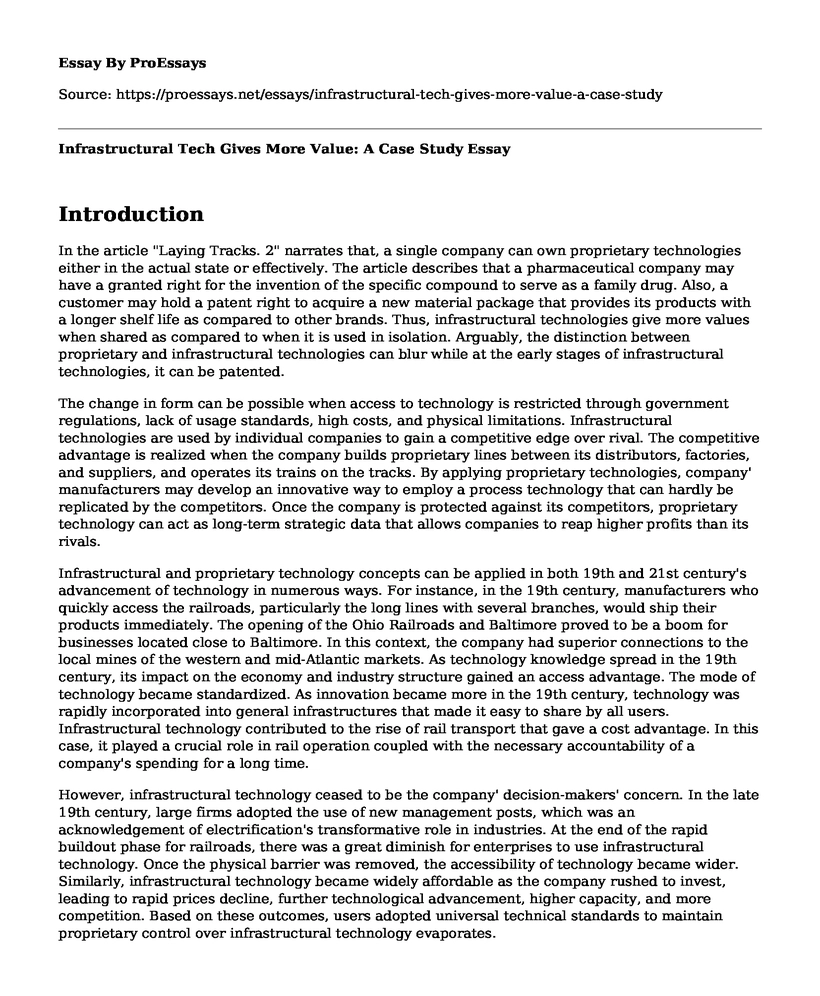Introduction
In the article "Laying Tracks. 2" narrates that, a single company can own proprietary technologies either in the actual state or effectively. The article describes that a pharmaceutical company may have a granted right for the invention of the specific compound to serve as a family drug. Also, a customer may hold a patent right to acquire a new material package that provides its products with a longer shelf life as compared to other brands. Thus, infrastructural technologies give more values when shared as compared to when it is used in isolation. Arguably, the distinction between proprietary and infrastructural technologies can blur while at the early stages of infrastructural technologies, it can be patented.
The change in form can be possible when access to technology is restricted through government regulations, lack of usage standards, high costs, and physical limitations. Infrastructural technologies are used by individual companies to gain a competitive edge over rival. The competitive advantage is realized when the company builds proprietary lines between its distributors, factories, and suppliers, and operates its trains on the tracks. By applying proprietary technologies, company' manufacturers may develop an innovative way to employ a process technology that can hardly be replicated by the competitors. Once the company is protected against its competitors, proprietary technology can act as long-term strategic data that allows companies to reap higher profits than its rivals.
Infrastructural and proprietary technology concepts can be applied in both 19th and 21st century's advancement of technology in numerous ways. For instance, in the 19th century, manufacturers who quickly access the railroads, particularly the long lines with several branches, would ship their products immediately. The opening of the Ohio Railroads and Baltimore proved to be a boom for businesses located close to Baltimore. In this context, the company had superior connections to the local mines of the western and mid-Atlantic markets. As technology knowledge spread in the 19th century, its impact on the economy and industry structure gained an access advantage. The mode of technology became standardized. As innovation became more in the 19th century, technology was rapidly incorporated into general infrastructures that made it easy to share by all users. Infrastructural technology contributed to the rise of rail transport that gave a cost advantage. In this case, it played a crucial role in rail operation coupled with the necessary accountability of a company's spending for a long time.
However, infrastructural technology ceased to be the company' decision-makers' concern. In the late 19th century, large firms adopted the use of new management posts, which was an acknowledgement of electrification's transformative role in industries. At the end of the rapid buildout phase for railroads, there was a great diminish for enterprises to use infrastructural technology. Once the physical barrier was removed, the accessibility of technology became wider. Similarly, infrastructural technology became widely affordable as the company rushed to invest, leading to rapid prices decline, further technological advancement, higher capacity, and more competition. Based on these outcomes, users adopted universal technical standards to maintain proprietary control over infrastructural technology evaporates.
Ideally, a company's fate is determined by broader forces that affect the overall economy, region, and industry. Data centres allow smart companies to break away from rivals. The influence of data centres in the 21st century is felt at a higher economic level as well as an individual company. If a country fails to install data centres, the local companies may suffer much. With the emergence of these technologies, organizations are likely to experience long-lasting macro-economic effects. The macro-economic impact may influence organisation profitability.
In terms of technology, data centres seem to be everywhere. At Dalles, the Google Company had established its data centres to store information. Infrastructural technology has brought into Google Company high-speed access for access to business. In the 21st century, the constructions of power stations in the cities reaped operating benefits of electrical power to urban manufacturers, namely printers and apparel makers. Companies that embraced the structuring of machines, electric power, and operating practices gain an advantage over their rival companies. Also, in the 21st century, the higher coverage, capacity, and speed changed business.
In the 19th century, companies that quickly recognized the use of infrastructure technology reaped an overwhelming and robust advantage. The extensive coverage of railroads enables companies to economically ship finished products instead of only industrial components and raw materials over long distances and broader markets. Long-distance shipments by railroads were marred by risks that changed the economies of many countries. As the years went by in the 19th century, there was a rapid expansion of railroads. Besides, there was rapid advancement in related technologies such as telegraphy and steam power. With the continuous improvement of technology, the transformation of commerce grew across the globe. Alongside railroad tracks, telegraph wire was connected. The connection of cables and rails roads aims at connecting producers, suppliers, and customers.
Conclusion
In conclusion, proprietary and infrastructural technologies have brought changes in industries that cannot be ignored. Unlike in the 19th century, technology has boosted the expansion of not only railways system in the 21st century, but also data centres. Hence, there is need to fully applied proprietary and infrastructural technologies in an organisation.
Cite this page
Infrastructural Tech Gives More Value: A Case Study. (2023, Feb 12). Retrieved from https://proessays.net/essays/infrastructural-tech-gives-more-value-a-case-study
If you are the original author of this essay and no longer wish to have it published on the ProEssays website, please click below to request its removal:
- Use of Smartphones on Patient Care and Information From the Database
- Innovation From an Organizational Viewpoint Dissertation Chapter Example
- Smartphone and Social Media Use in Healthcare Paper Example
- Article Analysis Essay on The Spreading of Social Energy
- Innovation & Culture: Strategies for Firm Success in Today's Market - Essay Sample
- Essay Example on Robots in the Workplace: Impact on Employment and Workforce
- Research Paper Sample on The Year 2000: A Significant Period of Global Change and Technological Advancements







